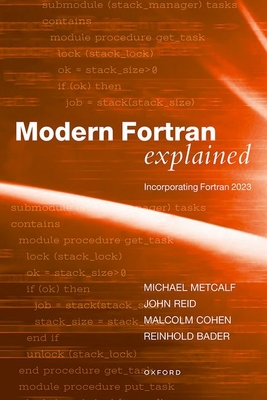Description
Fortran remains one of the principal programming languages used in high-performance scientific, numerical, and engineering computing. A series of significant revisions to the standard versions of the language have progressively enhanced its capabilities, and the current standard - Fortran 2023 - brings with it further additions and improvements. The language as defined by its most recent standards, with their introduction of object-oriented programming and of coarrays, is often referred to generically as 'Modern Fortran', and this term is increasingly used in the literature.
Thus, we see that Fortran's particular advantages as a high-end numerical language, especially where arrays are the main form of data object and/or where complex arithmetic is involved, are still to the fore. It is able to attain the highest achievable optimization, mainly because multi-dimensional arrays are 'natural' objects and because its pointers are highly constrained. There is every sign that Modern Fortran will continue to be used to tackle major scientific computing problems in the next decade and beyond and will long remain a living tribute to its early pioneers.
This third edition of Modern Fortran Explained expands on the second. The material contained in the four final chapters of the second edition have been merged into the main text, thereby offering, in 20 chapters, a comprehensive and uniform description of Fortran 2018. The additional features now brought by the 2023 standard, which are mostly relatively minor in nature, are described in two final chapters, the first on generic programming and the second on the other features. This structure enables the reader to distinguish clearly between what is old and what is new.
This new edition, written by experts in the field, three of whom have actively contributed to Fortran 2023, is thus a complete and authoritative description of Fortran in its latest form, with the intention that it remain the main reference work in the field.
About the Author
Michael Metcalf, Formerly of CERN, Geneva, Switzerland, John Reid, JKR Associates, Oxford, UK, Malcolm Cohen, Principal technical consultant, The Numerical Algorithms Group Ltd, Oxford, UK, Reinhold Bader, Scientific staff member at Leibniz Supercomputing Centre (LRZ) of the Bavarian Academy of Sciences, Germany After studying physics at University College London and a short spell at ICT, Michael Metcalf spent 32 years working on evaluation of data from large high-energy physics experiments at CERN, Geneva. He became a group leader and senior scientist. During this time, he became involved in Fortran standardization and was a member of the relevant committees for seven years. He wrote a number of books on the topic and lectured extensively. Now he is retired and resides in Berlin. After reading mathematics at Oxford University, John Reid lectured at Sussex University for five years and joined the numerical analysis group at Harwell, which moved to the Rutherford Appleton Laboratory in 1990. He wrote many Fortran programs for the group which appeared in the HSL Library. His research has mainly been on direct methods for sparse matrices. He has participated in Fortran standardization since 1983 and was convener of the ISO committee from 2000 to 2017. Now he is an Honorary Scientist at the Rutherford Appleton Laboratory and he continues to participate in Fortran standardization. After studying Computer Science and Mathematics at the Australian National University, Malcolm Cohen worked as a programmer in the public sector for three years. He joined the Numerical Algorithms Group in 1984 to work on Fortran Software Tools. Later, he took a year off in Iceland in 1987 to learn Icelandic, C, and graphics programming, and rejoined the NAG in 1988. He has been a member of the ISO/IEC Working Group on Fortran since 1988 and wrote the world's first Fortran 90 compiler, which released in September 1991. He has been the Editor of the ISO/IEC Fortran standard since 2005, responsible for Fortran 2008, Fortran 2018, and Fortran 2023. He was seconded to NAG's Tokyo office in 2006, and currently resides in Japan. After studying physics at Ludwig-Maximilians University in Munich, Reinhold Bader completed a PhD in solid state physics in 1998. He became a scientific staff member at LRZ in 1999 and group leader of the HPC systems and services in 2012. He developed basic and advanced course material for Fortran and other HPC topics since 2000 and has been involved with Fortran standardization in the context of WG5 since 2008. He is now officially a DIN representative (through LRZ) since 2013.

